
The Malmberget control room, where each operator is in charge of two Simba drill rigs.
Nordic Equipment for Worldwide Markets
Equipment manufacturers and service suppliers from the Nordic countries play a major
role in global exploration, mining and metallurgy. E&MJlooks at what they can offer.

As these companies have grown, they have often followed their markets by establishing subsidiaries that can provide equipment and service “on the doorstep,” so to speak. Sometimes this has come about by acquiring a holding in a local enterprise that was already in a particular market, leading perhaps to a subsequent full takeover. In other cases, Nordic companies have invested directly in new production facilities in a target country, following earlier export success. Whatever the reason, today Nordic equipment suppliers are represented throughout the world with a range of factories, agencies and service organizations, all supported by design and engineering expertise from their home country.
Think of the equipment used in a “typical” underground hard-rock mine: drills, bits, charging systems, loaders, haulers, drainage pumps, even level-to-level hoists. Nordic companies can supply them all, together with blasthole drills for surface mines, vehicle lighting systems, and emissions-compliant engines to power machines ranging from mobile crushers to standalone generators and heavy-duty haulers.
Think of the equipment needed to recover metals from often low-grade ores, and transform them into usable commodities: crushers, mills, flotation systems, thickeners, filters, pipework, valves, furnaces and fume-collectors. Nordic companies can supply them all, and can make sure that equipment being sent by land or sea arrives safely, on time. Add to these a raft of specializations in areas such as exploration technologies, wastewater treatment, industrial chemicals and environmental protection, and it is clear to see that while the Nordic region makes up only a small proportion of the wider world, its mining-sector suppliers have a lot to offer.
New Horizons for
Automated Drilling
It has been a busy year for Atlas Copco’s
underground mining division, including
acquisitions and a range of new product
launches—as well as the company celebrating its 140th
birthday. It began with its
purchase of the Swiss equipment company, MEYCO, bringing shotcreting expertise
to the Atlas Copco portfolio. It followed this
with an agreement with MEYCO’s former
owner, BASF, to cooperate on future developments in sprayed concrete chemistry
and equipment technology.
The company took the opportunity provided by the Bauma show in Germany to launch five new products for underground mining. These included the 40-kW COP 4038 rock drill for 43 mm to 64 mm drifter holes which, Atlas Copco claims, drills 20%-30% faster than its nearest competitor and is optimized for hard-rock conditions. Meanwhile, the COP 1800-plus drill series extends recommended service intervals by 50%. An updated Rig Control System was also featured, as was the new Underground Manager for drill rig planning and reporting. The company also introduced its fully dry drilling system on the Boomer XE3 C three-boom jumbo, which uses compressed air for hole flushing and a suction nozzle around the drill string to eliminate dust.

This was followed by the launch of the company’s Green Line of electric-powered underground loaders and trucks. The electric loader range now consists of the EST2D, EST3.5, EST14 and EST1030 Scooptrams, while the two electric trucks are the 35-mt capacity EMT35 and 50-mt EMT50. Power for tramming the electric LHDs is provided by the Gentrail GT325 portable generator.
For diesel-engined equipment, Atlas Copco has introduced Cummins Tier 4i engines as an option for its ST7, ST7LP, ST1030, ST1030LP and ST14 Scooptrams, and for the MT2010 underground truck. Benefits include lower ventilation requirements and fuel savings, the company said.
Drilling automation has been a major development area for the company over many years, with its Simba W462 rigs being introduced first at LKAB’s Kiruna mine, then at Malmberget in 1997. These in turn have been replaced with the latest Simba WL6 C rigs, which are equipped for fully automated, teleremote operation using a new interface and data system.
In the sub-level caving system used at Malmberget, 8- to 10-hole upward fans are drilled 3- to 3.5-m apart, with 102 mm-115 mm holes being drilled up to 47-m long. The Simba rigs are fitted with Wassara water-powered hammers to achieve minimum hole deviation over these lengths. Each fan blast generates around 6,600 mt of ore.
Each of the six rigs is expected to drill 2,100 m a week, with fully automated, unsupervised drilling during night shifts. The teleremote system allows the rigs to be operated with the aid of continuous video supervision and a laser guidance system up to 6 km from the underground control room, with the rigs being equipped with motion sensors that immediately shut them down if someone gets within 2 m of the machine.
Company-wide, recent equipment orders have included the supply of LHDs, trucks and drill rigs to Hindustan Zinc for its Rampura Agucha, Zawar and Kayad mines in India, drill rigs for First Quantum Minerals Cobre Panama copper project, and drill rigs and loaders for Minerven in Venezuela.
Metso Equipment for
Finnish Gold Mines
With its wide range of crushing, screening
and mineral-processing equipment, Metso
reported that it has been one of the leading
suppliers to the new generation of gold producers that is building up in the Nordic
region. Two of these in particular are
Nordic Mines Laiva operation in northern
Finland and Endomines Pampalo mine in
the east of the country.
Currently with a throughput capacity of 1.2 million mt/y of 1.6 g/t gold ore at Laiva, Nordic Mines produced 931 kg (29,900 oz) last year from selective openpit mining. Equipment supplied to the operation by Metso includes a jaw crusher, two cone crushers, two vibrating feeders, a ball mill, a flash-flotation unit, a number of conveyors and more than 70 slurry pumps of various types and sizes.

Endomines Pampalo operation is in the Karelian gold belt. With Metso having designed and supplied a state-of-the-art processing plant, Pampalo runs an environmentally “green” operation that avoids acid mine drainage and targets 100% water recirculation.
Endomines commissioned Pampalo in early 2011 at a cost of some €20 million. Last year it mined 250,000 mt of ore grading 4 g/t, and produced 867 kg (27,860 oz) of gold. It has recently completed a plant expansion project that has lifted nameplate capacity up to 420,000 mt/y.
While the main ore source at Pampalo is underground, Endomines has been evaluating a number of satellite deposits along the gold belt. Since these all lie within 30 km of the existing operation, ore will be trucked for processing at the plant there. In its most recent quarterly report, the company noted that overburden removal and trial mining at the Rämepuro satellite mine is under way, with full-scale mining expected to begin there next year.
According to Endomines CEO Markus Ekberg, the company has shown that even small-scale gold mining and production can be done in a sound and profitable way. Its construction strategy was to divide the work up into small, separate contracts, with Metso supplying the main mineralsprocessing system. “By doing this, we succeeded in constructing the mine well within the budget and planned schedules. The start-up of the Metso processing plant also went well. Our mine achieved a process utilization rate of more than 90% within two months,” Ekberg said.
The gold at Pampalo is hosted in green schist, and is recoverable using gravity and flotation. Since no cyanide or acid is needed, the tailings pond contains clean, potable water, with full process-water recirculation. “Thanks to Metso’s grinding and processing technology, our gold production has been successful, with more than 85% gold recovery,” Ekberg added.
The plant expansion has included the installation of a second grinding mill and more flotation cells, with the higher throughput meaning that lower-grade ore from the satellite deposits can be handled successfully.
Low Emissions and
Fuel Efficiency
According to Volvo Penta, the Volvo group’s
sales channel to the external engine market, world-leading OEMs are already signing
supply agreements for its Tier 4 final offroad diesel engines, with deliveries starting
in 2014. The company used this year’s
bauma show to launch its complete Tier 4f
5-16 liter off-road engine range, which uses
SCR (selective catalytic reduction) technology to meet the new emission requirements. “We currently have strong growth in
the off-road segment, and it is satisfying
that our new product program has been so
well received in the market,” said Volvo
Penta CEO Björn Ingemanson, at the time.
“The engines’ fuel efficiency and superior
cost of ownership are appreciated by more
and more customers.”
Since Volvo Penta introduced its first SCR engines in 2006, users have benefited from increased power and 5%-10% lower fuel consumption, the company stated. In addition, the catalytic converter is designed to last the life of the engine, so there has been no increased demand in terms of service intervals, or additional downtime.

Having already introduced as standard a heavy-duty cabling harness for its engines that are used in harsh, dusty working environments, this year Volvo Penta will also be launching the option of a heavy-duty cooling package for these units. The systems are targeted at applications such as stone crushers and screens, air compressors and other off-road equipment that works under conditions involving vibration and dust, with the aim of improving engine uptime and reducing the total cost of ownership.
The company recently received an order from Sandvik for engines to power the new UH450E track-mounted tertiary crusher. As this is driven electrically rather than with an on-board diesel, power comes from a TAD1651GE power-generation engine that is installed in a soundproof container. Not only does this cut noise emissions, but also improves the crushing unit’s energy efficiency, Volvo Penta stated.
Helping Prevent Downtime
on Earthmovers
The Danish supplier of oil-flushing and filtering equipment, C.C.Jensen, has expanded its product portfolio with a series of
heavy-duty filters, adapted to be installed
in the tough and challenging mining environment. Tests have shown that the payback time on offline oil filters for equipment such as dump trucks and excavators
is extremely short, the company said, with
the potential to make considerable savings
by preventing breakdowns and downtime.
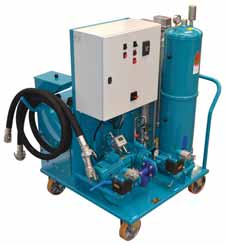
C.C.Jensen estimates that 80% of breakdowns are related to contaminated oil, and as most equipment has to work around the clock, the cost of a breakdown caused by water or dirt can, in a worst-case scenario, easily exceed $100,000. The new CJC heavy-duty filters offer a solution, with the company stating that they have proved their worth in the roughest conditions where machines have been subject to heavy vibration and shocks. Mobile equipment such as excavators, dump trucks and drill rigs can now operate for much longer without the risk of breakdown if they are equipped with offline filters for diesel, hydraulic and lubricating oils.
Tests with CJC oil filters on excavators have proved that after more than 6,000 hours, hydraulic oil is still cleaner than new oil, whereas oil without filters typically has to be changed after 1,500-2,000 hours. The design of the new heavyduty filters has been based on field trials done in cooperation with customers in Canada, Chile, Australia and South Africa, and C.C.Jensen pointed out that mining companies such as Anglogold Ashanti, Anglo American, BHP and Rio Tinto use its oil filters on mining equipment supplied by OEMs including Caterpillar, Hitachi, Atlas Copco and Sandvik.
While C.C.Jensen filters have been used effectively on stationary equipment in the past, the company has now expanded its market into mobile machines by fitting parts such as anti-vibration mountings. The electric motor has also been made more dust- and water-proof, while the filter insert has a very high dirt-holding capacity, so minimizing maintenance costs.
“Reliable machinery requires clean oil and a clean oil system,” said C.C.Jensen sales manager Bjørn Martinsen. “We are often seeing payback times of less than a year in mining applications, while the solution has a positive impact on the environment,” he added. “Mining companies are focusing more on environmental issues, and these filters represent a small investment but produce significant results in this context.”
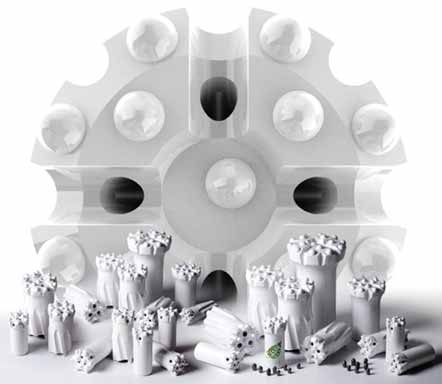
Top-performance Drilling Tools
With its home in Finland and a presence in
more than 90 countries, Robit Rocktools
specializes in top-hammer and DTH
drilling tools. The company pointed out
that since its roots lie in hard Scandinavian
granite and the Finnish mining industry, it
has an intimate knowledge of drilling in the
most challenging rock types.
Robit Rocktools’ product line covers all construction, quarrying and mining drilland-blast applications, from the softest to the hardest rock conditions. Tunneling is one of its most important customer segments, together with applications such as drifting and bolt-hole drilling. Its portfolio encompasses products such as drifting and tunneling bits, reaming equipment, bench and production drilling bits, rods, shanks, couplings, auxiliary tools such as grinding cups, button bits, and guide adapters.
The company has recently introduced a completely new range of carburized rods, up to 6,400-mm (21 ft) long for underground drilling. It has also launched new DS (drop center with straight body) and DSR (drop center with retrac body) series of mid-size button bits. Covering 60- to 92-mm hole diameters, these bits have extended lifetimes and give faster penetration, Robit said.
Building Rock-reinforcement
Capabilities
The Finnish company Normet specializes
in equipment used in underground mining
for shotcrete transport and spraying, highly
mechanized explosives charging, and
materials logistics. It also markets the
chemical admixtures used in shotcrete production and spraying.
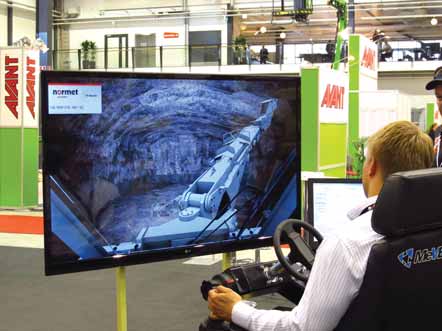
At the beginning of this year, the company bought the Norwegian rock-support technology specialist, Dynamic Rock Support (DRS), thereby adding the energyabsorbing D-Bolt system to its rock reinforcement product portfolio. A spin-out company from the Norwegian University of Science and Technology, DRS was founded in 2008 with the focus of providing reliable support technology for underground mines, particularly where challenging ground conditions involve squeezing or dynamic risk management. The D-Bolt is a rock bolt specifically designed to provide rock reinforcement in squeezing and burst-prone strata.
At the time, Normet’s president Tom Melbye said, “With the D-Bolt system, together with our sprayed concrete, grouting and injection technologies and products, we can now help our customers to make underground mines and tunnels safer, even in difficult strata and high stresses and deformations.” DRS is one of two companies representing Norway in the 2013-2014 European Business Awards competition, which focuses on companies that exhibit the highest levels of innovation, business excellence and sustainability.
Normet’s product line encompasses equipment used to mechanize scaling, shotcrete transport and spraying, explosives charging, lifting and access, materials and personnel logistics. It also has the Semmco shotcrete product line for the Latin American market, together with its TAM International range of shotcrete and construction chemical additives.
Flexibility from Scania
The Swedish truck manufacturer, Scania,
said it is using experience gained during
more than a century in the heavy vehicle
industry to provide a range of solutions for
global mining companies. Besides specialized mining trucks, it can supply buses for
crew transport and engines to power mining equipment and generator sets, as well
as container-based field workshops for onsite servicing, and training for drivers and
service staff. Customization is a key element here, with Scania working with individual customers to design an appropriate
response to their requirements.
Scania noted that transport in and from a mine often makes up 30%-60% of total operating costs. Rising fuel prices have put fuel consumption on everyone’s agenda, while the industry is challenged by volatile commodity prices and lower ore grades in many major deposits. As a result, the company said, secondary deposits are becoming increasingly interesting. However, these smaller operations (and extensions to existing mines) often have longer transport routes to the processing plant. This in turn provides an advantage for smaller, lessexpensive “road trucks” that are considerably more fuel-efficient than larger haulers.
Scania vehicles are available for every stage in a mining project, from exploration to reclamation. Used for on-site transport, trucks of the size that Scania offers can operate on narrow haul roads that are less expensive to build and maintain, while providing extra flexibility in terms of capacity. For off-site haulage, they can run on public roads if required. Its rigid dump trucks offer capacities up to 46 mt while Scania road trains for, say, concentrate haulage, can carry up to 120 mt.
The company points out that its vehicles and components are based on modular designs that use around 30% fewer parts than the industry average. This makes for significantly easier servicing and parts supply, as well as facilitating the recruitment and training of mechanics and technicians. Its field workshops use a modular container system that can quickly be brought into service.
Scania offers driver training, which may help save fuel as well as cut vehicle wear and tear, as well as tailored financing, leasing and rental solutions. In addition, it offers advisory services in logistics, transport planning, road economics and operational monitoring which, it said, can often contribute to improved production flows and increased productivity.
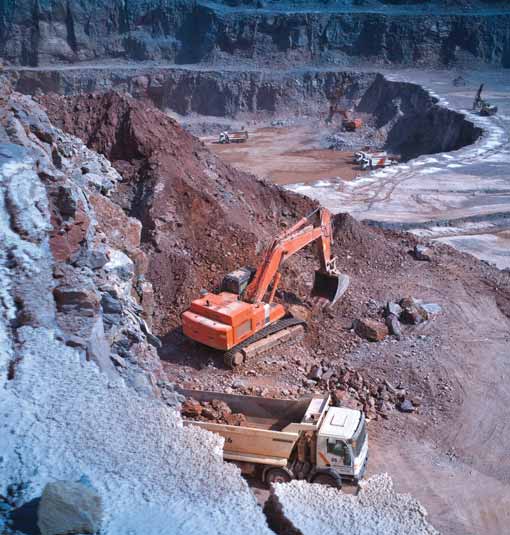
Steel for High Wear Applications
Finland’s leading steel-maker, Ruukki, has
recently added to its range of Raex wearresistant steels. Raex can withstand wear
and surface pressure, with the range having been expanded to include the thicker
wear-resistant steels needed in the mining
industry, according to the company.
Now made in thicknesses from 2 to 80 mm, Raex can be used to manufacture parts for heavy machinery and equipment designed for digging, loading, transporting and crushing ore. Applications include excavator and front-end loader buckets, tipper bodies for heavy earthmoving machinery, conveyor systems, crushers, silos and hoppers. The thinner grades in the Raex family have already been used for years in the transport industry and other applications where strong, wear-resistant steel is needed, Ruukki stated.
The company claims that the consistent quality of its Raex steels significantly prolongs equipment lifetimes, giving cost and competitiveness benefits for the end user. Choosing the optimum thickness of steel in the manufacture of buckets and tipper bodies, for instance, can help to reduce the overall weight of the equipment itself. This can increase the payload, which in turn benefits fuel consumption.
Ruukki explained that its Raex steels have been developed together with its customers, and have excellent cutting, bending and welding properties. Made using a direct-quenching method that both improves the properties of wear-resistant steels and makes them consistent in quality, Raex steels have a hard surface and strong microstructure, the company added.
Saving Energy with AC Drives
Positioning itself as the world’s largest
independent drives company, Vacon’s AC
drives are finding increasing numbers of
applications in the mining and metal
industries. Its products provide accurate
and reliable speed and torque control for
conveyors, crushers, grinding mills and
other electrical motor-driven equipment,
with its NXP and NXC AC drives offering
the kind of high power production required
for heavy material haulage and critical flow
control, the company said.
According to Vacon, running AC motors with variable-speed drives instead of constant or fixed speeds can save up to 50% in energy consumption, especially when operating pumps, fans, compressors and winches. AC drives are also much quieter than traditional hydraulic alternatives, and motors can be run up to three times faster than with hydraulic systems in applications such as slack rope handling. Vacon offers a complete product portfolio in the power range 0.25 kW to 5 MW, including air and liquid-cooled units and common DC bus components. Step-up medium voltage solutions are also available.
One example of its equipment in use, cited by the company, is at Yamana Gold’s Fazenda Brasileiro gold mine in northeast Brazil. Vacon’s AC drives were selected for the underground mine’s ventilation and pumping systems in a large retrofitting project. Fan speeds are controlled using the AC drives according to real demand, which saves energy.
In Western Australia, meanwhile, Vacon has supplied some of its NXC low-harmonic drives to the Greenbushes lithium mine. In an expansion project there, Automation Alliance, one of Vacon’s partners, was responsible for selecting and commissioning all the drives on site. Automation Alliance selected two NXC drives to control the new primary and regrind ball mills. Its principal electric engineer, Malcolm Barnes, said, “I was impressed with the drives’ design and performance. The modular design of the active front-end module is identical to that of the inverter module, which reduced the cost of holding spares on site for the customer. The communication interface also made it easy to integrate the drives into the plant control system.”
Overall, Vacon estimates that the use of its AC drives worldwide helped save around 50 TWh of energy in 2012—roughly equivalent to 20 hours of the world’s annual electrical energy production. The company stated that payback times for AC drives have continuously shortened, such that in pump and fan applications it can now be less than one year.
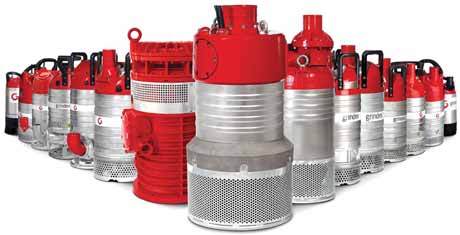
Grindex’s Next-generation
Pumps
Grindex launched an updated range of
drainage and sludge pumps at this year’s
bauma exhibition. These pumps deliver
increased running time and require less
maintenance, which reduces the total cost
of ownership, the company stated.
A world leader in electrical submersible pump technology, Grindex was founded in 1940 and since 1960 has been specializing in pumps for drainage, sludge and slurry applications. Built-in motor protection and an air valve mean that its pumps can run unsupervised for long periods, and even run dry for a length of time. The company exports to more than 100 countries and has a U.S. subsidiary.
In the new range, the Minex, Minette, Minor, Major, Master and Matador drainage pumps and the Salvador, Senior and Sandy sludge pumps have all been updated to deliver improved pumping performance, while the need for maintenance and spare parts has been reduced, Grindex reported. The updated pumps now have a new seal design with a robust metal housing that offers improved heat transfer and sealing function for a longer life.
The pumps now comprise fewer parts, which reduce the risk of leakage and speeds up maintenance. A new lifting handle and a deeper groove in the strainer also mean that they are more ergonomic, while the Minor, Major, Senior and Sandy have new lifting eyelets for hooks. In addition, dry-running performance has been improved with the introduction of more and better air valves, and a larger oil volume.
Improved hard-wearing features include new wear-resistant impellers for the Minex and Minette drainage pumps, a wear-resistant coating of polyurethane for all sludge pumps and a polyurethane option for the Minor to Matador drainage pumps. A further safeguard measure is the proven SMART motor protection, which cuts the power if the temperature gets too high or if it loses a phase. SMART also ensures the impeller turns in the right direction.
“At Grindex we are continuously working to develop our solutions,” said technical engineer, Jonas Bladh. “Many of the changes in this latest generation of pumps are based on conversations with our customers and field engineers. We’ve listened to what they have to say, and where an improvement could be made, we’ve made it.”
Improving Availability using
Guided Troubleshooting
From its headquarters in Aalborg,
Denmark, Dezide provides knowledge management systems for optimizing technical
troubleshooting processes in the mining
industry. The company specializes in tools
for maintenance troubleshooting on heavy
equipment, and on industrial rotating
equipment such as electric motors,
pumps, gearboxes and fans.
Users are guided through the troubleshooting process in a structured way, Dezide explained. Dezide Advisor can be used for on-site troubleshooting by field service engineers; for remote troubleshooting and guidance by surveillance-center staff; for automated diagnostics, monitoring, prediction and alerts based on live data from machinery and equipment; and as self-service troubleshooting tools for mine operators and engineers. By finding the most likely root cause, the system helps to minimize the overall cost and time of repair.
Dezide claims that Advisor operates well even in situations with missing, uncertain or conflicting input, and is easily integrated with SCADA and monitoring systems to include sensor data, error messages and other automated data readings in the troubleshooting process.
Its troubleshooting guides can be integrated with live data such as the last error codes produced by the machine controller, machine operating hours, engine hours, hydraulics information and so on, removing the need for manual evaluation of complex data.
The company gave a business case example for a mining excavator, such as an RH120E, in iron ore production. With a 2% increase in annual availability and lower unplanned downtime by using Advisor, the machine stands to produce additional ore worth some $3 million, it said. Used across a whole mining fleet, the Dezide solution could provide a positive ROI within a few months, it added.
Dezide handles the complete flow from machine breakdown, trying to resolve the issue remotely, to dispatching an engineer who continues the troubleshooting session on-site.
On-site disconnected troubleshooting ensures access to the knowledge base at all locations, even in remote mining environments. An online knowledge base for monitoring-center staff, integrated with various data sources, provides a quick overview of the situation and informed suggestions for problem resolution.
Other benefits include increased availability as problems are fixed faster, increased reliability, the potential for fewer mistakes to be made, lower costs as fewer spares are needed, less staff training, improved knowledge sharing, and the opportunity to identify faulty service processes and components, Dezide said.
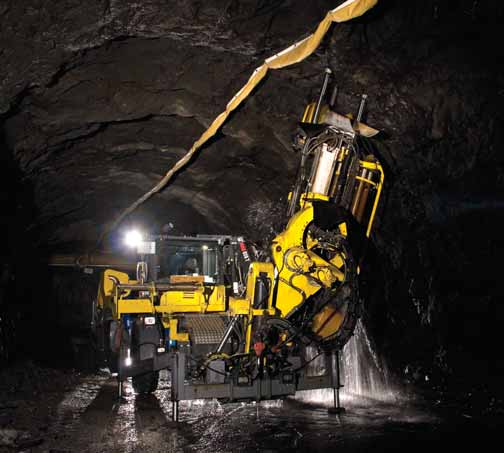
Water-powered Drilling
Boosts Ore Production
A leader in water-powered DTH drilling,
LKAB Wassara has a seven-model range
of hammers that cover hole sizes from
60 mm to 254 mm (2½ to 10 in.). Wassara
hammers normally use up to 300 l/min of
clean water at a pressure of up to 180 bar.
The company stated that water’s incompressibility means that the system can achieve higher efficiency, higher pressure and lower losses than traditional air-powered hammers. Hole sizes can be reduced, since the drilling accuracy is much greater, Wassara added, with water power giving consistently high drilling efficiency no matter what length the hole is. In addition, the company pointed out, a high-pressure water pump is much more energy-efficient than an air compressor, so energy consumption is reduced.
According to Wassara, when LKAB scaled up its production in 1990, it needed a drilling technology that could provide 60-m long blast holes with a maximum deviation of 1.5%, and at a lower energy cost. This was the challenge that led to the development of water-powered drilling, such that today, all production drilling at LKAB is done using Wassara’s waterpowered DTH hammers. Thus far, the company added, a total of 18 million m (59 million ft) of blastholes have been drilled using Wassara technology at LKAB’s Kiruna and Malmberget mines.
Although LKAB has relied on sub-level caving throughout its history, 1990 marked a step change in its requirements. In order to increase iron-ore production, the vertical distance between sub-levels was more than doubled from 12 m to 28 m, with the longest blastholes jumping from 28 m to 56 m in length. This cut the amount of sub-level development needed by 70%, while the output per blast increased from 1,200 mt in the 1980s to the 10,000 mt achieved at Kiruna today.
The use of longer blastholes also brought a new requirement for increased drilling accuracy and hole straightness. Good fragmentation of the rock depends on minimal deviation of the blastholes from the design pattern, with Wassara reporting that its hammers meet LKAB’s requirement for 1.5% maximum deviation day-in, day-out.
Today, LKAB’s production drilling involves holes up to 56-m long, depending on the shape of the ore body. The penetration rate achieved is 0.5 to 1 m/minute with 115 mm drill bits, with media holes and slots also being drilled using the Wassara system. A typical installation uses a Wassara W100 hammer fitted to a 115-mm drill bit, working on Atlas Copco or Sandvik drill rigs, with clean water being handled by pumps supplied by either Kamat or Hammelmann.
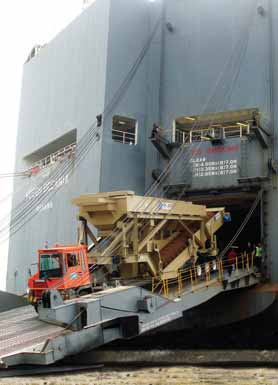
Creating Optimal Logistics
Solutions
Based in Esbjerg, Denmark, Blue Water
Shipping is an international shipping, transport and freight-forwarding company. It has
more than 60 offices worldwide that handle
transport and logistics solutions for all types
of cargo and for all destinations. The company stated that its team of experts has
years of experience within worldwide transport and logistics for the mining industry,
and that it offers a wide variety of services
focusing on Africa, Greenland, Canada and Australia where an increasing number of
mining projects are under way.
“We emphasize on personal service using our on-site experience with loading/unloading operations, consulting and pre-shipment surveys and inspections,” Niels Mikkelsen from the company’s mining projects division told E&MJ. “With expert insights of the industry, Incoterms and planning of multiple transport solutions we meet and exceed our clients’ expectations,” he added. “Our services also include project management and full track and trace of all shipments, ensuring a reliable handling of mining equipment.”
In-house specialists from Blue Water Shipping includes stevedores, port captains, naval architects and HSSEQ (health, safety, security, environment and quality) specialists, ensuring quality all the way. Being used to handling challenging project cargo and being a part of a flexible international organization, Blue Water Shipping is proactive in creating the optimal solutions to any challenge along the way, Mikkelsen stated.
Exploration Drilling in a
Sensitive Environment
One of the largest exploration drilling contractors in the Nordic region, Oy Kati specializes in diamond core drilling. Its goal is
to provide its mining and exploration
industry clients with high-quality geological data in an efficient and reliable manner. In addition to drilling, it carries out
down-hole surveys using state-of-the-art
equipment, thereby providing its clients
with valuable additional data. Kati’s headquarters are located in western Finland.
Kati noted that it has extensive experience working in demanding conditions, from underground mines to high-altitude sites, and from arctic regions to the Sahara desert. Its operations have been based on sustainable development principles for years, and comply with the ISO 14001 environmental management standard.
With its diamond core drilling and surveying, Kati said it produces high-quality core and other information in an efficient and trustworthy manner. Its client base consists of various major and junior exploration and mining companies, as well as the dimension-stone industry, environmental research institutes, power companies, the Geological Survey of Finland, municipalities and other public-sector organizations.
By using deviation surveys, drill-hole locations can be located extremely accurately in 3-D. This is essential information for a company planning mining activities, as it determines precisely from where each piece of core in the core box has been recovered. Kati claims to offer the widest selection of deviation survey tools, including surveys using real north-seeking gyros to give the most reliable survey results.
The company has designed and built its own modern core-drilling units that are efficient, suitable for all kinds of terrain, minimize any environmental impact and provide safe, comfortable working conditions. Kati can also provide underground rigs and helicopter-transportable rigs. Nearly all its rigs are rubber tracked, which makes moving easier and minimizes any stress on the environment, while its closed-circuit drilling system saves up to 75% of the water being used and simplifies cuttings separation.
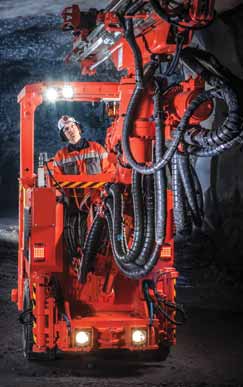
Sandvik: Automation and
Energy-saving Focus
From the U.S., Sandvik reported that it
recently worked with the Wyoming-based
coal producer, Cloud Peak Energy, on field
trials for its high-pressure compressor management system (CMS) for its blasthole drill
rigs. The CMS tackles the two primary issues
facing mines today—increasing productivity
and reducing environmental impact—by
providing a solution to the inherent inefficiencies of rotary blasthole drills that have a
direct connection between the engine and
the compressor. It works by isolating the
compressor and eliminating the need to
maintain pressure when the machine is not
drilling. This reduces the load on the engine,
saving a significant amount of fuel and
reducing engine wear, Sandvik said.
Initial trials on a retrofitted DR460 drill at the Drayton coal mine in New South Wales produced 33% fuel savings, according to Sandvik. For the Cloud Peak trial, the CMS was retrofitted to a 14-year-old D75KS rotary rig that had already run up nearly 60,000 hours. While Sandvik had initially estimated there would be a 23% fuel saving, results showed that the figure was more than 26%, equivalent to annual cost savings of more than $100,000 and some 300 mt of carbon emissions. Cloud Peak Energy subsequently bought two new Sandvik rigs with CMS installed, the company reported.
In early September, Sandvik used the opportunity provided by its international customer day in Tampere, Finland, to introduce new drill rigs and drilling tools, as well as marking the official launch of the two underground mine trucks that were featured in the June edition of E&MJ (p. 57). For underground mining, the company unveiled its DD422i Axera and DD211 development drill rigs, while its surface-mining drill range has been extended with the introduction of the new Pantera DP2000 top-hammer rig.
The electro-hydraulic DD422i is the first of the company’s next generation underground hard-rock drill rigs, and was described by Ulla Korsman-Kopra, vicepresident for underground development drills, as offering industry-leading levels of safety, productivity and automation. “It provides a clear direction to the future of mining, incorporating a wide variety of new features for more efficient drilling,” she said. Scheduled for introduction to the market next year, the DD422i includes an intelligent control system that is ready for tele-remote operation using Sandvik’s AutoMine Drilling system.
A twin-boom rig, the DD422i can cover a 10.3- × 6.6-m (34- × 22-ft) face area. Tramming power comes from a 119-kW Cummins Tier 3 or 4f-compliant diesel.
Meanwhile, the DD211 is a single-boom electro-hydraulic development rig for narrow-vein applications, featuring safety upgrades from its predecessor, plus more automation. A key feature is its ability to negotiate corners as tight as a 2.5-m radius. Developed primarily for the Latin America, North America and CIS markets, the rig uses Sandvik’s THC561 electro-hydraulic control system, covering constant-speed drilling controls, stop-and-return automatics and air-mist flushing with rock-drill return.
The Pantera DP2000 is the top-hammer version of the rig exhibited at the EuroMining show (See pp.66-69). With a distinctive new-look, Sandvik said it has developed the new Pantera range to take advantage of mining industry trends toward fully autonomous operation—with options that allow owners to take advantage of automation technology as their needs and mining operations change. Equipped with the company’s new RD2045C hydraulic tophammer drill, and designed to use 20-ft (6.1-m), 127-mm-diameter drill tubes, the DP2000 can drill 152-mm to 178-mmdiameter holes 36-m deep.
New drill tools launched in September included the RH460 range of DTH hammers, with the 4-in. and 5-in. versions available now, and 3.5-in., 6-in. and 8-in. units still to come.
Specialized Buckets
for Mining
The Danish company, Viby Attachment, specializes in producing buckets for hydraulic
excavators, wheel loaders and other materials-handling machines. It has delivered more
than 40,000 units during its 50-year history,
supplying buckets to OEMs and end-users.
Viby manufactures its excavator buckets in Hardox and Weldox steels for all machine types and uses. Various teeth brands can be fitted according to customer’s specifications, it pointed out.
For wheel loaders, its high-tip bucket is the only one available with completely protected cylinders, it added, while standard loader buckets can be provided with spill guards, wear plates and other options, including quick-hitch systems.
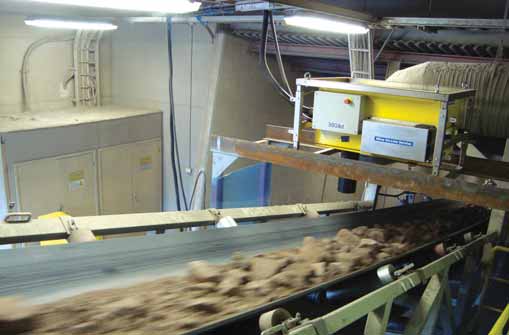
Real-time Analysis for
Better Grade Control
IMA Engineering supplies geochemical
analyzers to customers in the mining, construction, cement and industrial-minerals
industries. Its products include analysis
systems for online cross-belt applications,
slurries, truck and train loading, and exploration and mine-grade control. The
acronym IMA stands for Innovative Mineral
Analyzers, the company explained.
IMA designs and manufactures fully automatic instant drill-cutting sampleranalyzers for Atlas Copco, which distributes them under the brand name OREAlyzer. These units are used on reverse-circulation sampling and blasthole drill rigs to produce accurate depth- and location-specific ore-grade data that can then be used to produce 2-D or 3-D loading maps for selective loading for grade control. Their accuracy has been verified by excellent correlation between the OREAlyzer results and those from adjacent diamond and reverse-circulation sampling, IMA stated, with OREAlyzer units having been delivered and tested in various copper, nickel, iron and limestone mines in Scandinavia, Australia and the U.S.
IMA also manufactures various types of on-belt analyzers using XRF, LIF and LIBS analysis technology, which can be controlled through a process management station. Fast analysis in less than a few seconds is essential for identifying waste rock and different grades of crusher-run ore for sorting purposes, the company said. Its FCA (Fast Conveyor Analyzer) system allows up to eight analyzers to be connected to one station, while several stations can be linked for data-view or system-control distribution.
XRF analyzers monitor crushed ore on a conveyor belt, or analyze oxide and elemental compositions in finely ground dry powders or wet slurries at concentrators and other process plants. Typically they are used in cement production and in metallic mineral applications to monitor the main oxides. Laser-based (LIF, LIBS) analyzer systems are designed for the identification of mineral types or quality classes to provide real-time quality-control information, with their main use being dilution control in run-of-mine ore.
IMA said that another interesting application is the use of its bucket analyzers for sorting ore and waste rock while loading. It has a full-scale research unit that interested customers can rent and use for on-site trials. The system is especially useful for underground stopping or block-caving, IMA said, while it can also be used in surface mines for mill-feed homogenization.
Minerals-processing
Technology Developments
The Finnish supplier of minerals-processing
and metallurgical technologies, Outotec,
reported it has added high-pressure grinding
rolls (HPGR) to its comminution product
line, which also includes autogenous-grinding mills, SAG mills, ball mills, rod mills,
scrubbers and HIGmills (high-intensity
grinding). HPGR technology can be applied
to various minerals-processing applications
where project feasibility demands lower
energy consumption, Outotec explained.
The company has also developed its own range of HPGR tires. It pointed out that since they operate in a highly aggressive environment, HPGR tires are plagued by problems such as studs cracking, breaking or shattering. Studs can also be undermined or washed out along the tire base, separating them from the tire. In addition, Outotec said, the edges on HPGR tires can often experience uneven or high wear, leading to compromised grinding performance and premature breakdowns.
Outotec said its HPGR tires are built for maximum performance and durability, incorporating a unique design with extremely high-wear material. The stud and edge design deliver optimized throughput over the tire life cycle and extend the intervals between services, it added.
Turning to filtration, Outotec has responded to the mining industry’s increasing demand by upscaling its Larox FFP 2512 pressure filter series to the new FFP 3512 for even higher-capacity production requirements. It claims that the innovative design of the membrane filter plate is the key to achieving larger capacities, and even more efficient process results, with the FFP being designed for the dry stacking of tailings, providing energy and water savings through water recycling.
Both the 2512 and 3512 series share the same footprint to simplify future expansion requirements. The 3512 filters offer filtration areas of up to 991 m 2 with fast pack opening, and are equipped with the latest technology filter plates that have been designed for mining conditions, Outotec stated.
Outotec’s recent supply contracts have included the complete process system for First Quantum Minerals’ Kevitsa coppernickel mine in northern Finland, which came on stream in August 2012. Outotec delivered two autogenous-grinding mills, a pebble mill, 73 TankCells ranging from 20 to 300 m3 , three high-rate thickeners, two Larox PF 25 m 2filters (later expanded to 32 m 2 ), an Outotec PSI 500 particlesize analyzer for the grinding circuit, and a Courier 6i elemental analyzer for the flotation circuit for froth control. Other equipment included 36 FrothSense imagers, an Outotec ACT (Advanced Control Tool) for flotation optimization, and its Integrity concentrate reporting tool.
Outotec also trained the plant’s operators using its Virtual Experience simulation system, has service agreements covering the various analyzers, is providing First Quantum with mill-lining services, and has a two-year operations and maintenance agreement for the filters.
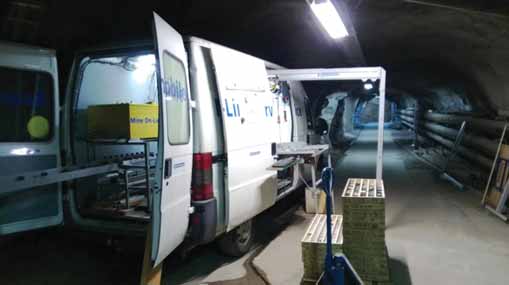
Real-time Information
for Exploration Results
A sister company to the analyzer supplier,
IMA, Mine On-Line Service (MOLS) provides the exploration and mining industry
with services such as core-logging and
online geochemical analyses, especially on
drill cores and till samples. MOLS also
does drill-cutting and grade-control application studies, and consulting for optimal
solutions at various points in a mine’s value
chain. The company stated that its focus is
not only on eliminating capex and reducing
opex, but on generating value from the
accurate differentiation of ore and waste,
the ore grade and its location.
MOLS said that its rapid analysis services allow several hundreds of meters of drill-core scanning a day. Analysis reports are available virtually instantly for the client to view remotely through their secure Remolog online reporting and logging tool. Along with patented sampling instruments, 3-D blast-field modeling technology, heapleaching optimization and real-time reporting software, IMA analyzers are a great asset to MOLS.
MOLS has been digitizing drill cores in national core stores and mines across the Nordic countries for years with its Scanmobile mobile geochemical analysis lab. This documents drill-core data using non-destructive XRF elemental analysis, as well as using built-in digital imaging technology to evaluate characteristics such as the rock quality (RQD), and to identify minerals. The results are fed to the online Remolog browser, and can be viewed remotely from anywhere with an Internet connection. The Scanmobile system is currently being developed to include integrated magnetic susceptibility analysis and other analytic techniques.
Recent projects have included digitizing a large volume of drill core at a nuclear waste storage site. More than 4,000 core boxes with more than 18,000 m of core were photographed in a few weeks, with the images being analyzed for RQD and any weak minerals content. MOLS has also undertaken grade-control studies for mines, most recently for a nickel mine. Using a trailer version of IMA’s OREAlyzer, the production bench was closely analyzed and compared to the mine’s own data from the area. The results showed significantly higher ore losses and dilution than had been predicted.
As the representative for Blast Movement Technologies Ltd. in Scandinavia, MOLS can combine elemental analysis information from IMA analyzers and blast movement data to create accurate pre- and post-blast 3-D block models, displaying the ore-content distribution in production benches with GPS coordinates.
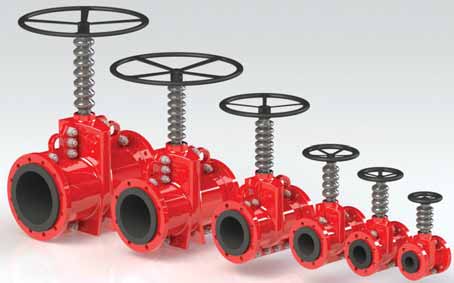
Pinch Valve Technology
from Flowrox
With its headquarters in Lappeenranta,
Finland, and subsidiaries in the U.S.,
Australia and South Africa, Flowrox specializes in supplying solutions for abrasive,
corrosive and other demanding shut-off,
control, pumping and dosing applications
in a wide range of process industries. The
company has accrued more than 30 years
of experience in the elastomer technology
used in its heavy-duty valves and pumps.
The company recently launched its new PVG pinch valve for processes involving pressure resistance, heat, abrasion, corrosion and aggressive slurries. The PVG is a robust pinch valve with strong metal body, simple bullet closing mechanism and opening tags in the inside sleeve as standard, Flowrox told E&MJ, noting that the design is based on direct feedback from the field, and responds to customer demand from various industries.
The PVG has evolved from the earlier elastomeric PVEG valve, designed for endusers needing a lightweight, but durable valve. While the concept was widely liked, the valve’s plastic body limited the applications for which it could be used, which led Flowrox to build the new, stronger version based on the earlier successful design.
The PVG valve offers process benefits that are based on the valve structure, the company said. In the open position, the valve is at full bore with no flow restrictions, so it is an integral part of the pipeline. Anything flowing through the pipe can also pass through the valve. Being a full-bore design, PVG valves require the least pumping energy and minimize the system head pressure. Installation is trouble-free, and the valve includes pre-installed rubber sleeves that withstand tough process conditions. This ensures long lifetime and minimal maintenance costs, Flowrox added, with potential applications including discharge lines, thickeners and pump isolation.
Flowrox also recently reported on an application involving another one of its products, the PVE pinch valve. A Danish utility was experiencing relative short service intervals (six-to-nine months) on a valve in the control system for lime slurries used in power-station flue-gas desulphurization. Its replacement with a PVE unit led to a number of benefits, according to Flowrox, which later supplied the utility with a second valve for use on a similar application.
The valves have been reliable in operation, with significantly better wear resistance than the units they replaced. In addition, Flowrox said, the service interval for the valves was stretched to more than 24 months without causing any disturbance to the lime slurry control.
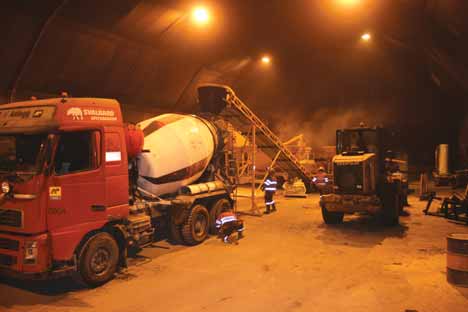
Shotcrete System
for Svalbard
The Danish company fibo intercon, which
manufactures and delivers mobile, semimobile and stationary concrete-batching
plants, told E&MJthat it has supplied a
batching plant to the Norwegian coal producer, Store Norske, for the production of
sprayed concrete (shotcrete). The M2200
plant has a production capacity of
25–45 m3
/h, is mounted on a three-axle
trailer and weighs 11 mt.
The unit consists of four aggregate hoppers, an agitator pan mixer, dosing equipment and a control unit for the batching computer. Fibo intercon also supplied other equipment for the plant, including a 14-m long belt conveyor for transporting the mixed concrete, a big bag silo for cement and a preweight silo for cement to ensure high-quality concrete.
Store Norske is using the batching plant at its Svea Nord mine. The M2200 operates from inside a large tent, with aggregates being fed using a wheel loader, and the finished concrete being taken underground using a truck mixer for delivery to the shotcreting rig.
When the Lunkefjell mine is opened, the plant will be moved underground through Svea Nord to its new location—and as the roof height in Svea Nord is only 2.5 m, fibo intercon built the M2200 2.46-m high. The company pointed out that by using a mobile unit like this, plant positioning can be optimized, with cost and time savings.
Fibo intercon noted that this is not the first time it has delivered equipment for mining and tunneling projects, with one of its most widely used plants being a horizontal 30-m³ capacity cement silo that is used in low-headroom situations. CEO Claus Holm, said, “We expect that mining will become an even more important market for us in the future, since many of our plants are tailored for sites with limited space or are easy to customize for mining and tunneling projects.”
SSAB Extends Hardox
Network
Wear-resistant Hardox plate from the
Swedish steelmaker, SSAB, is widely used
in mining-sector applications. The company recently opened a Hardox Wearparts
facility at Quilicura in Chile, where Hardox
plates coming from the U.S. and Sweden
are cut before delivery to mining and manufacturing customers in the country.
SSAB has also been working on a joint project with Scania to develop a lightweight, but heavy-duty tipper truck for use in applications such as coal mining. Introduced at last year’s bauma China show, the vehicle’s Hardox 450 body uses SSAB’s Arc Design, which gives a lightweight convex shape without floor stiffeners. Destined in this instance for use in Mongolia, where temperatures can dip to -50°C in winter, the body floor can also be heated using the truck’s exhaust to reduce the chance of the load freezing and sticking.
Meanwhile, SSAB has given notice that it intends to increase its use of legal action to protect its Hardox trademark against infringements—especially, but not exclusively in China.
“We would like all of our customers to be aware of the fake Hardox wear plate available on the market,” the company said. “The technical proprieties and wear performance of Hardox copies cannot compete with the genuine Hardox.”
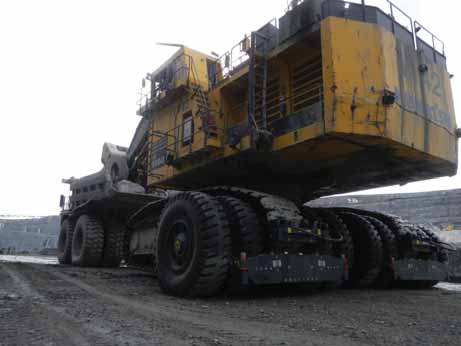
Sleipner Shifts Bigger
Excavators
The Finnish manufacturer of specialist
equipment-moving systems, Sleipner, has
pushed the limits of the machine sizes
it can handle further with the introduction
of its E550 model. Using this, open-pit
and quarry operators can now move excavators weighing up to 565 mt around their
sites quickly and cost-effectively, the company stated.
The new unit uses essentially the same concept as earlier versions, with large wheels, and ramps with axles, but with a new frame structure. Once one end of an excavator’s tracks have been driven onto the ramps and lifted off the ground, the excavator turns around, places its boom on the bed of a dump truck and lifts the other end of its tracks. With the whole excavator now clear of the ground, the truck can move it to wherever it is needed in a fraction of the time needed for walking it the same distance on its tracks.
Trials on the E550, designed for excavators between 450 and 565 mt, took place in Sweden earlier this year, using a Komatsu PC5500 excavator and a Caterpillar 793 hauler. Sleipner reported that the evaluation was completely successful, with the first E550 unit then being delivered to an operation in Africa. According to the company, its key customers are requesting even larger Sleipner equipment for their operations, and it believes that this model will have the biggest impact yet on mining operations—cutting transport times by up to 80% and increasing excavators’ efficiency and productivity.
Having the ability to move larger pieces of equipment brings its own challenges, of course, and Sleipner has now developed a towing application for demanding conditions. Consisting of a kinetic rope that is easy to use, safe and light, it allows two trucks to be used in tandem to tow an excavator on a Sleipner unit on steep (10%-15%) uphill grades, or when extra towing capacity is needed.
Dampening to a Whole New Level
With its company slogan, “Lights for Heavy
Duty,” Nordic Lights produces LED, HID
(Xenon) and halogen work lights for the heavy-duty on- and off-road industries in
harsh working environments. As the company noted, powerful machines require
powerful lights, with its principal product
criterion being durability.
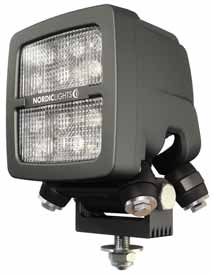
For many years, Nordic Lights has been developing and patenting different dampening solutions for the heavy-duty lights used on earthmoving and other equipment. Why dampen a work lamp? The right kind of dampening will greatly increase a lamp’s resistance to shock and vibration. Not only will the lamp take much longer to break, but the different components inside it will also last longer, needing far less maintenance and fewer replacements. The strain on the application caused by mounting the work lamp will also be reduced, making the vehicle less vulnerable.
The company has now introduced its patented QUAKE dampening system, which takes protection against vibration and shock to a whole new level, the company said. In a standard dampening system, powerful strains can develop on the dampeners, whereas in the QUAKE system, forces are distributed uniformly. As a result, Nordic Lights said, the QUAKE dampening system lasts much longer and can withstand much bigger shocks and wider ranges of vibration. And if the dampening system can withstand more punishment, so can the work light and also the application upon which it is mounted, the company pointed out.
In addition, because the QUAKE system withstands a wider range of vibration, it is now possible to mount more powerful work lamps on vehicles. As a result, the question of where the work light is mounted is less critical since the dampening system is kinder on the vehicle, as well as reducing maintenance and down-time, and saving space.
Noise Monitoring for Mines
The Danish company, Brüel & Kjaer, a
world leader in noise and vibration measurement, told E&MJthat it has started to
make inroads as a supplier of environment
monitoring services to the global mining
industry. Noise Sentinel is a subscriptionbased monitoring service that helps mines
manage their noise, ground vibration, dust
and air-quality impact.

According to the company, Noise Sentinel is unique—not just because it combines all these disciplines in one solution, but because it provides a full service offering including instrumentation, installation, service and data management. This makes it possible for mine staff to focus on their core job instead of managing technology, Brüel & Kjaer added.
As well as being used in large mining operations in Australia and Brazil, Noise Sentinel has been operating for more than a year at Goldcorp’s Porcupine mine in Timmins, Ontario. Monitoring takes place at 17 different locations around the mine in challenging environmental conditions. Noise, vibration, dust and air-quality levels are continuously measured up to twice per second, and are automatically transmitted to the Noise Sentinel server over the Internet where they are processed and compared to a variety of compliance criteria. If levels exceed these, the mine staff are alerted immediately. Alerts are shown on a real-time control app that runs 24/7 in the mine control room, and are transmitted via email or SMS. This enables operational staff to take immediate action to reduce any impact.
As Brüel & Kjaer pointed out, noise does not just come from the mine. The system has shown that there is a general “urban hum” that includes lawn mowers, motorcycles and other road traffic. During the summer, evening concerts raise noise levels above defined limits. Noise Sentinel helps by recording audio when limits are exceeded. Replay can help to determine if the cause was due to the mining operations or other sound sources in the community. It can also use directional noise monitoring, which is able to measure noise levels in a specific direction— for example, the mine—and exclude noise from others, such as the community.
Improving Work-flow Systems
As the need for automated, online information in mining has increased rapidly, the
Tamtron group has answered this challenge
by developing a robust, reliable on-board
dump-truck scale and ID tracking system
with various ways of transferring data wirelessly and on-line.
Tamtron’s DV dump-truck scale for heavy-duty use consists of two axle load cells that replace the rear pins of the dump body, a pressure transducer that measures the pressure in the piston cylinder, and an advanced display instrument, designed for on-board use. The use of both types of transducer ensures that the weighing result is correct in every position of the dump body. Weighing takes place simply by lifting the body, with inbuilt angle compensation ensuring that the weighing is accurate even on rough ground. DV scales can be installed on most trucks, including underground haul trucks, the company said.
Tamtron scales are equipped with a large on-board touchscreen display—relaunched earlier this year with a new user interface in full color. Both the display and keyboard are illuminated, enabling roundthe-clock use. On-board weighing means that it is no longer necessary to drive to a weighbridge, which saves time.
The DV scale range covers all needs from basic weighing to advanced data transfer versions. The weight data are stored in the system’s memory, which can generate detailed records of the material type, amount loaded and location of the material. Tamtron pointed out that the DV scale helps to avoid overloading, so fleet utilization is more efficient and servicing is reduced.
Meanwhile, Tamtron’s ID tracking system means that identifying vehicles and personnel on a work site need not be difficult or take up human resources. Its automatic RFID systems—based around RFID tags and an RFID data-collection terminal—log identification data directly, with these data then readily available. The ID data can also be integrated into existing business processes like HR and ERP for further information management. There are various options for the data network, and all of Tamtron’s systems are tailored to meet customers’ needs.
Cutting Concentrate
Drying Costs
The Kopar group, the Finnish manufacturer
of process equipment for smelting operations, has designed a new steam dryer to
dry concentrates before they enter the furnace. According to the company, the new
dryer—which is patented in Europe—offers
many features that enhance the drying
process in comparison to existing dryers.
Since most smelting operations produce steam, using this is an economical solution compared to using outside energy sources. Another positive aspect is environmental. Since the new dryer works at lower temperatures, the process also produces lower emissions.
The company explained that the European patent is fundamentally about the arrangement of the heat-pipe system that consists of heat-transfer elements. The heat pipes are co-rotating, which means less mechanical wear on the steam tubes, so maintenance intervals are longer.
The structure includes several new features: no pressurized pipes in supporting contact; no massive construction inside the dryer; fewer steam-distributing pipes; a high heat area-to-drum volume ratio; and a low length-to-diameter ratio.
Kopar noted that the new dryer, which is available in several sizes, is aimed primarily at copper smelters but that other metal concentrates and ores can be processed as well.
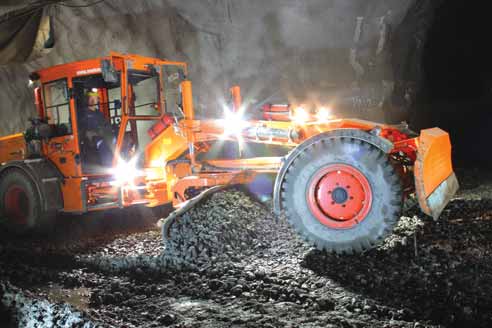
Maintaining Roadways
UndergroundA
A pioneer in motor-grader technology, the
Finnish company, Veekmas, is the Nordic countries’ only manufacturer of these specialized machines. Its product portfolio
includes graders for traditional construction and show/ice removal, together with
low-profile motor graders for use in hardrock underground mines.
Still a family-owned company that has been building graders since the early 1980s, Veekmas draws its product-development ideas from customer feedback as well as its own operating experience. Having established a dealer network on five continents, last year it launched its underground graders in both Australia and Mongolia. More machines are now scheduled for delivery to Mongolia, and it will deliver its first graders to Russia later this year. “We have a record number of motor graders in manufacturing at the moment, with the demand for underground graders stronger than it has been for many years,” Sanna Halttunen, the company’s export director, told E&MJ. As a result, Veekmas has been taking on new staff and has built a new assembly hall in preparation for the expected increased demand.
Veekmas currently offers three underground grader models. The 8.1-mt FG 5 C is powered by a 75-kW engine, is barely 2-m high and has a 4.9-m maximum outside turning radius with a front blade. The FG 7 C weighs 9.8-mt with a 90-kW engine, and is 2.46-m high with a 4.95-m maximum turning radius, while the company’s largest machine, the FG 15 C, weighs 16-mt, is 2.66-m high, has a maximum outside turning radius of 7-m without a front blade and is powered by a 150-kW engine.
Recent improvements to the FG 7 C have included a new electrically controlled system for the hydraulics, making the machine easier for the operator to use, new ROPS certification for the machine’s strength and sturdiness, even better visibility from the operator’s position, and the option of front-wheel braking to make the grader even safer in demanding underground conditions.
Veekmas stated that while a motor grader is the most suitable machine for proper road maintenance tasks, underground conditions are different from those on the surface. Hence, it is challenging to use a traditional grader underground where tunnels can be narrow, the walls are close to each other and there are sharp turns. By contrast, its machines are specifically designed for these conditions, being low and strong with an automatic, hydraulically operated blade suspension system that helps reduce shock impact loads on the frame.
Mining Pipework
Sweden’s Alvenius offers two systems of
pipework and fittings for mining, hot-dip
galvanized and thermoplastic (TP)-coated.
Hot-dip galvanized systems are used for
applications such as transporting water,
compressed air, slurry and backfill, and
for dewatering.
In business now for more than 60 years, Alvenius offers both the K10 and Victaulic systems, with K10 being a shouldered system for pressures up to 25 bar (360 psi) and Victaulic being a grooved system for pressures up to 80 bar (1,160 psi). Both are available in pipe diameters of 48 mm-508 mm (2-20 in.).
Coating steel pipe internally and externally with thermoplastic provides a solution for handling corrosive fluids at pressures of up to 70 bar (1,000 psi). TP pipes are available with diameters from 89 mm to 508 mm (3½-20 in.) and are typically used in applications such as heap leaching, dewatering, process water, fire fighting and for solutions with a high acid or chloride content.
Commissioning Drives
at Oyu Tolgoi
Since the beginning of 2011, Sweden’s
Hägglunds Drives has been a fully integrated part of Bosch Rexroth, although the
name is used for the radial piston motors
and hydraulic drive power units that drive
systems such as conveyors, bucket-wheel
reclaimers, ship unloaders, cement kilns
and other heavy-duty applications.
Bosch Rexroth has a total of 10 drives and 21 electric motors in operation at the giant Oyu Tolgoi copper-gold mine in Mongolia. The company reported that two of its service technicians, recently scheduled to carry out warranty work on some Hägglunds equipment there, ended up commissioning all of the main conveyor drive systems on site.
The two technicians were originally intended to replace 21 electric motors to suit the harsh climate conditions at the mine. However, faced with an urgent requirement to get the operation opened on schedule, they were first tasked with commissioning the drive on the mine’s longest conveyor. This took four days, including testing. It quickly became apparent there were numerous wiring faults in the electrical systems that were connected to the Hägglunds’ equipment, so the technicians had to supervise the entire start-up process.
Following the successful start-up, and with the replacement work completed, the technicians were entrusted with commissioning the remaining nine drives. Because the specifications were unavailable for the site-installed couplings and pipe runs, Bosch Rexroth sent out its own flushing equipment and skilled service staff. The piping was cleaned out and eventually all 10 drives were commissioned. What had initially been slated as a straight-forward replacement job turned into a two-month marathon, although, as the company noted, it was able to sell the original electric motors for use in another part of the mine.
Rack-and-Pinion Elevators
Since its introduction of the Raise Climber
in 1957, Alimak Hek has provided personnel and materials elevator systems to
the mining industry. Its current industrial rack-and-pinion elevator range includes the SE and SE-H models, which
have load-carrying capacities of 2 mt and
3.3 mt, respectively.
The company’s elevators are built to a modular car design that provides up to 30 different sizes. Made of Alimak’s selflocking, aluminum profiles, the wall panels meet different elevator needs, and create adaptable floor and roof configurations, it said.
Typical mining-sector applications could include underground access, as well as running between different operating floors in crushing plants, concentrators, smelters and pellet plants. Underground, Alimak elevators are well-suited for providing a secondary, emergency access route. They can be easily installed, and are relatively cheap to do so because no hoist room is needed. In surface plants, meanwhile, they provide quick access from level to level in situations where operators have different pieces of equipment to monitor and control.
Borehole Survey Tools
Aid Exploration
With its headquarters in Trondheim,
Norway, and with branch offices in Hong
Kong, South Africa and South America,
since 1988, Devico has been specializing
in directional core drilling for the mining
and tunneling industries. The company
recently introduced DeviShot, which, it
claims, is the most innovative multishot
survey tool on the market.
Devico said DeviShot is a magnetic survey tool that can be operated as either a single- or multi-shot instrument at constant or variable depth intervals. Whether surveying exploration boreholes, grout curtains or blast holes, DeviShot’s robust integrated running gear enables operation at exceptional depths, the company added.
DeviShot is equipped with an integrated IP68-rated Nomad PDA system powered by DeviSoft Mobile software. Using Brilliant Blue Technology (BBT) to communicate wirelessly with PDAs in the field, DeviShot provides quick results that can be further plotted and analyzed using DeviSoft, or quickly transferred to clients via a USB flash drive.
The DeviShot comes pre-assembled for use straight from the box, and features a BBT activation system to ensure minimal power consumption and longer battery life. DeviShot’s limited maintenance requirements and integrated survey data quality control features also help provide results in a quick, precise and cost-efficient manner.
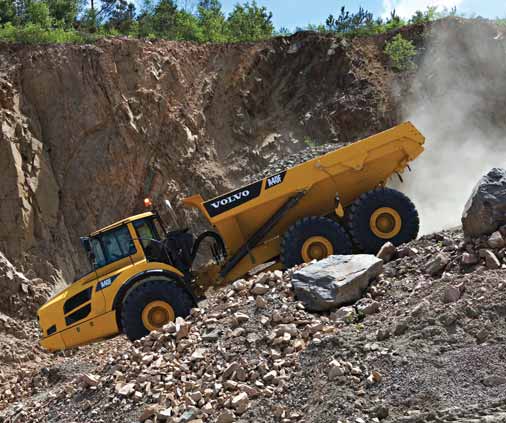
Volvo Targets Further
Efficiency Improvements
Volvo Construction Equipment (Volvo CE)
reported that it is continuing to roll out its
latest wheel loaders, articulated haulers,
and hydraulic excavators for the mining and aggregates sectors worldwide. “Mines
and quarries represent the largest portion
of our business in many regions and for
some product ranges,” said David Nus,
global director for mining, quarry and
aggregates. “No other supplier offers such
a broad range of mobile solutions to mines.
The recent launch of our new FMX trucks
extends this leadership in the on/off-road
environment. The FMX has been very well
received by miners around the world.”
The company pointed out that its latest G-Series wheel loaders, F-Series articulated haulers and D-Series excavators feature Volvo powertrains suited for the emissions regulations of each market. Volvo was one of the first suppliers to bring Tier 4i/Stage IIIB-certified machines to the market in early 2011, with all Volvo CE ranges on schedule to include Tier 4f/Stage IV engines starting in 2014.
The industry’s first wheel loader in the 35-mt weight class, the L250G, was specifically developed for customers in mining and aggregates, offering increased capacity over traditional 30- to 32-mt class machines when digging, loading or rehandling.
Volvo CE’s latest F-Series articulated haulers have been updated to offer better visibility through the front windscreen, side windows and rear door, a patented, simplified load/dump brake interface and an integrated retarder/brake function now combined into one pedal for simplified use. The A35F and A40F ADTs can also be equipped with the company’s patented full suspension (FS) option, which increases operator comfort and will be important when whole-body vibration regulations coming into force in some markets.
Meanwhile, Volvo’s D-Series crawler excavators—such as the larger EC340DL, EC380DL and EC480DL models—now feature improvements such as faster digging and travel speeds, intelligent hydraulics, and enhancements to the undercarriage to extend reliability. The company’s unique boom float function also raises productivity and speed during truck loading, while increasing operator comfort and fuel efficiency. “This is free production for a mine, and more comfortable for the operator,” said Nus.
Volvo CE is exploring a range of new fuel-efficiency technologies for future use in its equipment, while looking at ways of improving existing technologies. “We believe there is still a lot of potential for fuel savings and increased performance from further developing traditional mechanical drivetrains,” Nus added. “Acquisition costs of new technology must be outweighed by operating cost savings that are reliable. The proven reliability of existing drivetrains, backed by a mature support network, is a practical advantage for our customers today in mines and quarries.”
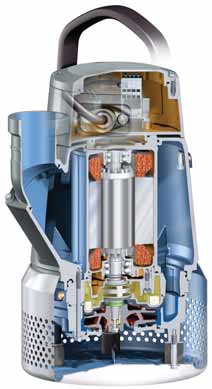
One practical innovation, he said, is Volvo’s Optishift solution for wheel loaders, which can improve fuel efficiency in most applications just by integrating systems in a more intelligent way and simplifying operator control. “Optishift benefits any truck-loading or load and carry application—or nearly all loader operations. Gains in fuel efficiency have been measured at more than 15%,” he said.
Flygt Submersible Pumps
for Mining
Part of the Xylem group, Flygt has been
producing dewatering pumps since 1930
from its plant in southern Sweden. Its first
submersible came in 1947, and since then
it has been one of the market leaders in
submersible pump technology with a raft of
innovations to its credit. Aside from its
Emmaboda facility, the company now has
production units in the U.S., India, China
and Argentina.
Xylem’s mining-sector product range encompasses both Flygt and Godwin pumps.
Flygt submersible pumps cater to a wide range of applications and needs, the company said. Its cast-iron 2000-series pumps; the 2600-series for tough applications in mining and construction, with a sludge version also available; the stainlesssteel 2700-series for corrosive and abrasive liquids; the heavy-duty 5000-series for pumping slurry; and the most recent addition to its range, the Flygt BIBO 2800.
The BIBO 2800 pumps handle flows of up to 100 l/s (1,500 U.S. gpm), heads up to 90 m (300 ft), and solids of up to 80 mm (3.2 in.) in diameter. They are available with power ratings from 3.2 to 18 kW (50 Hz) or 5.9 to 27 hp (60 Hz). Flygt said it has designed them to allow dry running, reduced the number of parts to simplify maintenance and inspection, and included wear-resistant hydraulics. Other features include the company’s Dura-Spin system to help flush abrasive materials away from the impeller neck, its Spin-Out design to protect the outer seal by removing abrasive particles, and use of a Hard-Iron impeller and suction cover to reduce wear and resulting downtime.
Speaking at the launch of the new BIBO range at this year’s bauma show, Xylem product manager Daniel Westin said, “The reliability and capability of the original Flygt BIBO dewatering pump is renowned within the industry and set the standard for submersible dewatering when it was first launched in the 1960s. This design forms the core of the new generation of BIBO pumps, which now includes the most advanced pumping technology.”
| The Danish Mining Technology Group Formerly known as the Danish Mining & Quarry Group, the Danish Mining Technology Group (DMTG), represents highly skilled companies servicing the global mining industry, including consultants, service providers, suppliers and subcontractors. Denmark is home to a large number of highly specialized companies that focus on producing effective equipment and solutions for the international mining industry. Many of these companies are among the world leaders in their fields. Some are focused on traditional core mining technology, while others offer ancillary services. Their success in the mining industry originates from centuries of developing cutting-edge solutions and know-how for business areas where Danish producers have taken a global lead—for example, in renewable energy and offshore oil and gas. The many years of experience they have accrued have been diversified into the mining sector, which is why Danish suppliers are represented worldwide in the mining industry today. The DMTG provides a shortcut to key suppliers. Its members service both mining companies and OEMs worldwide, providing innovative high-quality equipment, services and solutions. The DMTG is part of the Danish Export Association, giving it access to a large pool of expertise. More information about the organization, together with a full membership list, can be found at www.dk-mining.com. |